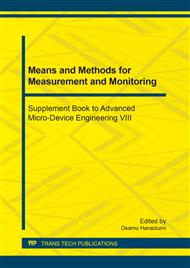[1]
S.K. Kawatra, and A.K. Bakshi, On-line Viscometry in Particulate Processing,, Mineral Proc. and Extrac. Metall. vol. 14, p.249–273, (1995).
DOI: 10.1080/08827509508914126
Google Scholar
[2]
J.M. Dealy and T.O. Broadhead, Rheometry for Process Control,, Rheological Measurements (Collyer, A.A., Cleg, D.W., eds), p.666–722, Chapman and Hall, London, (1998).
DOI: 10.1007/978-94-011-4934-1_21
Google Scholar
[3]
H.A. Barnes, On-line or Process Viscometry—A Review,, Applied Rheology, vol.9, p.102–107, (1999).
Google Scholar
[4]
W. O'Connor, S. McEntee and D. O'Callaghan, In-line Viscometry in the Dairy Processing Industry,, J. Society of Dairy Technology, vol.48, p.44–49, (1995).
DOI: 10.1111/j.1471-0307.1995.tb02465.x
Google Scholar
[5]
D. C-H.Cheng, A Review of On-line Rheological Measurement,, Food Science and Technology Today, vol.4, no.4, p.242–249, (1990).
Google Scholar
[6]
D. Kilcast, Instrumental Assessment of Food Sensory Quality,, Woodhead Publishing Series in Food Science, Technology and Nutrition, pp.129-162, (2013).
DOI: 10.1016/b978-0-85709-439-1.50023-7
Google Scholar
[7]
I. Arana, Physical Properties of Foods: Novel measurement techniques and applications. Boca Raton: Taylor & Francis. pp.43-44, (2012).
Google Scholar
[8]
D. Weihs, T. Hadad, R. Gurka and A. Liberzon, Flexible Blade for In-Line Measurement of Low-Range Viscosity,, Chemical Eng. Sci., vol.91, no.22, pp.130-133, (2013).
DOI: 10.1016/j.ces.2013.01.018
Google Scholar
[9]
Sudip Banerjee, Amiya K.Jana, Observer-based Extended Generic Model Control of a Reactive Batch Distillation,, Chemical Engineering Science, vol. 179, pp.185-197, (2018).
DOI: 10.1016/j.ces.2018.01.020
Google Scholar
[10]
H.J. Kim, D.P. Goodall, Disturbance Estimation and Cancellation for Liner Uncertain Systems,, Proc. of IFAC2015, vol. 38, no. 1, pp.304-309, (2005).
Google Scholar
[11]
M. Yan and Y. Shiu, Theory and Application of a Combined Feedback–Feedforward Control and Disturbance Observer in Linear Motor Drive Wire-EDM Machines,, International Journal of Machine Tools and Manufacture, vol.48, no.3-4, pp.388-401, (2008).
DOI: 10.1016/j.ijmachtools.2007.09.006
Google Scholar
[12]
L. Ljung, System identification: Theory for the user,, Englewood Cliffs, NJ: Prentice-Hall, (1987).
Google Scholar
[13]
S. Hashimoto, Y. Jiang, A. Basari and J. Wei, Development of a Torque-Sensorless Viscometer for Food Processing Applications,, Proc. of ICAMechs2015, Sat P03-04, pp.154-157, (2015).
DOI: 10.1109/icamechs.2015.7287146
Google Scholar


